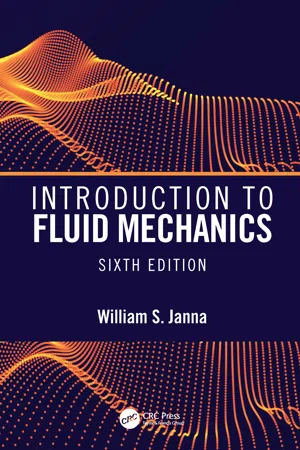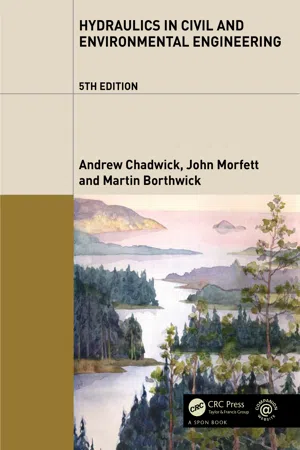Fluid Mechanics Applications
Fluid mechanics applications involve the study and practical use of the behavior of fluids, such as liquids and gases. This field is essential in various engineering disciplines, including aerospace, civil, and mechanical engineering. It encompasses the analysis of fluid flow, pressure, and forces, and is applied in designing aircraft, pipelines, pumps, and hydraulic systems, among other technologies.
5 Key excerpts on "Fluid Mechanics Applications"
- eBook - ePub
- William S. Janna(Author)
- 2020(Publication Date)
- CRC Press(Publisher)
...1 Fundamental Concepts Fluid mechanics is the branch of engineering that deals with the study of fluids—both liquids and gases. Such a study is important because of the prevalence of fluids and our dependence on them. The air we breathe, the liquids we drink, the water transported through pipes, and the blood in our veins are examples of common fluids. Further, fluids in motion are potential sources of energy that can be converted into useful work—for example, by a waterwheel or a windmill. Clearly, fluids are important, and a study of them is essential to the engineer. After completing this chapter, you should be able to: Describe commonly used unit systems; Define a fluid; Discuss common properties of fluids; Establish features that distinguish liquids from gases; and Present the concept of a continuum. 1.1 DIMENSIONS AND UNITS Before we begin the exciting study of fluid mechanics, it is prudent to discuss dimensions and units. In this text, we use two unit systems: the British gravitational system and the international system (SI). Whatever the unit system, dimensions can be considered as either fundamental or derived. In the British system, the fundamental dimensions are length, time, and force. The units for each dimension are given in the following table: British Gravitational System Dimension Abbreviation Unit Length L foot (ft) Time T second (s) Force F pound-force (lbf) Mass is a derived dimension with units of slug and defined in terms of the primary dimensions as 1 slug = 1 1 bf ⋅ s 2 ft (1.1) Converting from the unit of mass to the unit of force is readily accomplished because the slug is defined in terms of the lbf (pound-force). Example 1.1 An individual weighs 150 lbf. a. What is the person’s mass at a location where the acceleration due to gravity is 32.2 ft/s 2 ? b. On the moon, the acceleration due to gravity is one-sixth of that on earth. What is the weight of this person on the moon? Solution a...
- eBook - ePub
- B.H Brown, R.H Smallwood, D.C. Barber, P.V Lawford, D.R Hose(Authors)
- 2017(Publication Date)
- CRC Press(Publisher)
...As in structural mechanics, the aeronautical engineers have been there before us. Many of the modern computational fluid-dynamics (CFD) structures, algorithms and software were developed originally in or for the aeronautical industry. Some simplifications, such as that of inviscid flow, can lead to equations that are still worth solving for complex geometries. Special techniques have been developed, particularly for the solution of two-dimensional problems of this type. These are not discussed here because they are not particularly relevant to problems in biofluid mechanics. Turbulence is a phenomenon of primary interest to aerodynamicists, and this is reflected in the number of turbulence models that are available in commercial software and in the richness of the literature in this field. Moving boundaries (pistons and valves) are of great interest to automobile engineers in the modelling of combustion processes, and again facilities to model events featuring the motion of a boundary have existed for some time in commercial software. Of much more interest to those involved in biofluid mechanics are the problems of the interaction of soft and flexible structures with fluid flow through and around them. Historically structural and fluid-dynamic analyses have been performed by different groups of engineers and physicists, and the two communities had relatively little contact. This situation has changed dramatically in recent years. It is the authors’ belief that we stand on the verge of a revolution in our abilities to handle real problems in biofluid mechanics. 2.8.1 The differential equations For an incompressible fluid the continuity equation is ∂ u ∂ x + ∂ v ∂ y + ∂ w ∂ z = 0 where x, y and z are a set of Cartesian coordinates and u, v and w are the velocities in these three directions. The momentum equation in the x direction for a Newtonian fluid, in the absence of body forces,...
- Andrew Chadwick, John Morfett, Martin Borthwick(Authors)
- 2013(Publication Date)
- CRC Press(Publisher)
...These efforts had an impact on every aspect of engineering fluid mechanics. In the 1930s, the efforts of Nikuradse (in Germany), Moody (in America), Colebrook (in Great Britain) and others resulted in a clearer understanding of pipe flows and, in particular, of the factors affecting pipe friction. This led directly to the modern methods for estimating flows in pipes and channels. Since 1945, the advent of the electronic computer and advances in sensing and data logging equipment have revolutionised many aspects of hydraulics. Our understanding of the nature of turbulence, steady and unsteady flows in channels, sediment transport and maritime phenomena have developed rapidly. This led to developments in mathematical modelling and hence to ever-improving computer software. Furthermore, the availability of the Internet means that information can now be rapidly communicated around the world. Today’s engineer therefore has the tools to achieve more effective and economic designs. Hydraulics research continues on an international scale to seek solutions to the many pressing problems in water and environmental management. There is therefore every reason to expect that engineers and scientists working in this area will face exciting and difficult challenges which will make the fullest demands on their skills....
- Amithirigala Widhanelage Jayawardena(Author)
- 2021(Publication Date)
- CRC Press(Publisher)
...Although fluid mechanics form the backbone of hydraulics, it also has a great deal of contributions based on empirical studies. Such contributions came from Weisbach who studied friction in pipe flow, Darcy who studied flow through porous media, Chezy and Manning for their respective equations for uniform steady flow, Moody for Moody diagram for friction factors, and Nikuradse also for a clearer understanding of friction in pipe flows. These and other significant developments in fluid mechanics and hydraulics are summarized in Chapter 2. Modern-day major hydraulic structures in the world are briefly described in Chapter 24. 1.3 Hydrology Hydrology can be defined as the science that treats the occurrence, circulation and distribution of earth’s water resources and their interaction with the environment, including living things. It is a multi-disciplinary subject with contributions from civil engineering, soil physics, agriculture, forestry, geomorphology, geography, etc. with emphasis on measurement, recording and publication of basic data, analysis of such data to develop and expand fundamental theories, and application of the theories and data to practical problems. Although the definition covers the entire spectrum of processes in the hydrological cycle, the treatment in this book is confined to hydro-meteorology, surface water and groundwater. Snow hydrology, which is important in cold regions, is not covered in this book. The modern-day understanding of hydrology follows the concept of the hydrological cycle conceived by Leonardo da Vinci in the 16th century. Since then, there has not been much significant developments in the understanding of the hydrological cycle until about 1674...
- eBook - ePub
Introduction to Engineering Mechanics
A Continuum Approach, Second Edition
- Jenn Stroud Rossmann, Clive L. Dym, Lori Bassman(Authors)
- 2015(Publication Date)
- CRC Press(Publisher)
...20 Fluid Dynamics: Applications That we have written an equation does not remove from the flow of fluids its charm or mystery or its surprise. Richard Feynman, 1964 We have found two distinct ways to apply the fundamental concepts of mass conservation and ∑ F = m a to fluids. We now want to identify some canonical problems of fluid mechanics, their historical context, and their relevance to us. Both solid and fluid mechanics are enormous fields, with many rich details; in this book, we have been necessarily brief with both of them. We encourage further study of both areas, and of the field of continuum mechanics; please consult the References listed at the end of this book. 20.1 How Do We Classify Fluid Flows? The Navier–Stokes equation contains terms corresponding to several possible forces on a fluid element. If we look at it again, we can name the source of each of these forces: ρ D V D t inertia = − ∇ p pressure + ρ g gravity (body force) + μ ∇ 2 V viscous stress. (20.1) We would like to have a way to quantify the relative effects of these forces, and of other factors, on a given flow; this way, when faced with an intriguing fluid mechanics problem, we could decisively say whether viscosity or inertia was the more dominant effect, and how much more dominant. The most useful result would be a dimensionless parameter—that way, it would not matter whether we were dealing with SI or US units; a certain numerical value of this parameter would represent the same type of flow in either unit system. It is apparent that by taking the ratio of the inertial and viscous terms of the Navier–Stokes equation, we could obtain this quantification. This ratio will clearly go as ρ/μ. Unfortunately, this ratio ρ/μ has dimensions of time/length 2. To make it dimensionless, we need to multiply it by something with units of length 2 /time. The easiest way to construct this “something” is to multiply the velocity V by a characteristic length scale of the problem, say L...




